The Diels-Alder (D-A) reaction, namely, [4+2] cycloaddition between a conjugate diene and a dienophile, is one of the most important and widely used chemical transformations to form carbon-carbon bonds with excellent stereochemical control. To obtain only the desired isomer out of four possible isomers, synthetic efforts have been focused on the development of chiral catalysts for regio-, diastereo-, and enantioselective Diels-Alder reactions. Although significant progress has been made to control the enantioselectivity in the Diels-Alder reaction via the use of chiral Lewis acids, Brønsted acids and organocatalysts, efficiently producing otherwise disfavored exo-stereoisomers in enantiomerically pure form is still challenging despite limited successful examples in which α-substituted acrolein or cyclopentadiene was used in asymmetric Diels-Alder reactions.
After decades of speculation, a number of Diels-Alderases have been discovered. Now, a dozen monofunctional Diels-Alderases are known in the biosynthetic pathways of microbial and plant natural products, or by computational design, or from the mammalian immune system. These usually catalyze endo-selective Diels-Alder reactions with high enantioselectivity. While endo catalysts are interesting and valuable, exo-selective Diels-Alderases, especially for synthetically valuable Diels-Alder reactions are rare.
On December 10th, 2021, Prof. Xiaoguang Lei and collaborators published a paper entitled: “Enzymatic control of endo- and exo-stereoselective Diels-Alder reactions with broad substrate scope” in Nature Catalysis. In this work, they reported the discovery of two homologous groups of FAD-dependent enzymes that catalyzed intermolecular Diels-Alder reactions on the same substrates with opposite endo/exo selectivity and high enantioselectivity. They showed that these enzymes were effective chemoenzymatic catalysts with a wide range of diene and dienophile substrates. The crystal structure of an unprecedented exo-selective Diels-Alderase was determined at 3.0 Å resolution. Based on the structure and computational investigation of the catalytic mechanism, they designed and prepared mutant enzymes that reverse the stereoselectivity from exo to endo. A combination of structure-based comparison, computational studies and mutational studies had revealed two different catalytic mechanisms that controlled the endo/exo selectivity in these enzymatic Diels-Alder reactions.
These synthetic endeavors demonstrated that this family of enzymes exhibited both good substrate promiscuity and high stereoselectivity. With the mechanistic understanding of how excellent endo/exo selectivity is achieved in similar active sites, the synthetic utilities of these Diels-Alderases will be further improved via rational protein engineering or directed evolution with the ultimate goal of customization for different types of intermolecular stereoselective Diels-Alder reactions.


Prof. Xiaoguang Lei from the College of Chemistry and Molecular Engineering of Peking University and Prof. K. N. Houk from the Department of Chemistry and Biochemistry of University of California, Los Angeles are the co-corresponding authors. Lei Gao, Yike Zou, Xiaojing Liu and Jun Yang are the co-first authors. The work received financial supports from the National Key Research & Development Plan, the National Natural Science Foundation of China, the Beijing Outstanding Young Scientist Program, and Beijing National Laboratory for Molecular Sciences.
Original link for the paper: https://www.nature.com/articles/s41929-021-00717-8